Bronze Summer |
|||||||||||||||||||||||||
 |
 |
||||||||||||||||||||||||
Knitted jacket in DROPS Air. Piece is knitted top down with raglan, lace pattern and V-neck. Size: S - XXXL
DROPS 221-4 |
|||||||||||||||||||||||||
|
------------------------------------------------------- EXPLANATION FOR THE PATTERN: ------------------------------------------------------- GARTER STITCH (back and forth): Knit all rows. 1 ridge vertically = knit 2 rows. PATTERN: See diagrams A.1 and A.2. RAGLAN: Increase 1 stitch on each side of 1 stitch in stockinette stitch (stitch with marker thread) in every transition between body and sleeves (= 8 stitches increased on row). Increase 1 stitch by making 1 yarn over. On next row purl yarn overs twisted to avoid holes. Then work the new stitches in stockinette stitch. V-NECK: All increases are done from the right side. Make 1 yarn over inside 1 edge stitch in garter stitch (= 1 stitch increased) in each side. On next row (wrong side) purl yarn over twisted to avoid holes. Then work the new stitches in stockinette stitch. Increase 2 stitches in total on every increase row (1 stitch in each side). DECREASE TIP (applies to sleeves): Decrease 1 stitch on each side of marker thread as follows: Work until 3 stitches remain before marker thread and knit 2 together, knit 2 (marker thread is between these stitches), slip 1 stitch knitwise, knit 1, pass slipped stitch over stitch worked. BIND-OFF TIP: To avoid a tight bind-off edge you may use a larger needle size. If this also is too tight, work a 1 yarn over after approx. every 4th stitch while binding off (bind off yarn overs as regular stitches). BUTTONHOLES (applies to right band when garment is worn): Decrease for 5 buttonholes on right band. 1 buttonhole = work 2 stitches together and make 1 yarn over. On next row knit yarn over to make holes. Bottom buttonhole should be approx. 2 cm = ¾" from bottom edge and top buttonhole where V-neck begins. Place the remaining 3 buttonholes evenly, approx. 8-8-8-7½-7½-7½ cm = 3⅛"-3⅛"-3⅛"-2⅞"-2⅞"-2⅞" between each buttonhole. ------------------------------------------------------- START THE PIECE HERE: ------------------------------------------------------- JACKET - SHORT OVERVIEW OF THE PIECE: Work yoke back and forth on circular needle from mid front, work top down. AT THE SAME TIME increase V-neck and raglan. Now divide yoke for body and sleeves. Work body back and forth on circular needle, top down. Work sleeves in the round on double pointed needles/short circular needle, top down. At the end work a neck edge/band around the opening on jacket. YOKE: Cast on 70-72-74-76-78-80 stitches (including 1 edge stitch in each side towards mid front) on circular needle size 5 mm = US 8 with Air. Purl 1 row from wrong side. OVERSVIEW OF THE NEXT SECTION: Now start the pattern on the sleeves, at the same time increase for raglan and V-neck – therefore read the entire next section before starting. Insert 4 marker threads in piece as follows (without working the stitches): Count 3 stitches (= front piece), insert 1 marker thread in next stitch, count 21 stitches (= sleeve), insert 1 marker thread in next stitch, count 18-20-22-24-26-28 stitches (= back piece), insert 1 marker thread in next stitch, count 21 stitches (= sleeve), insert 1 marker thread in next stitch, 3 stitches remain on row after last marker thread (= front piece). Then work in stockinette stitch on stitches on front pieces and on back piece, and A.1 (= 21 stitches) over stitches on each sleeve, AT THE SAME TIME on first row from right side increase for RAGLAN in every transition between body and sleeves – read explanation above. When A.1 has been worked 1 time vertically continue with A.2 (= 25 stitches) over stitches in A.1 and continue increase for raglan every other row (i.e. on every row from right side) until increase has been done 22-25-27-29-33-36 times in total on each side of the 4 stitches with marker threads. Now continue increase on back piece and on front pieces 2 more times (do not increase on sleeves, increase has been done 24-27-29-31-35-38 times on back piece/front pieces). AT THE SAME TIME on 6th row (i.e. on 3rd row from right side) increase for V-NECK in each side towards mid front – read explanation above, as follows: Increase every 6th row 4-5-6-7-8-9 times, every 4th row 3 times in total (= 7-8-9-10-11-12 stitches in total increased in each side towards mid front). REMEMBER THE KNITTING GAUGE! After last increase for raglan continue without increases until piece measures 22-25-27-29-33-36 cm = 8¾"-9¾"-10⅝"-11⅜"-13"-14¼", increases for V-neck should now be finished. There are now 276-304-324-344-380-408 stitches on needle. Work next row as follows: Work the first 35-39-42-45-50-54 stitches (= front piece), slip the next 69-75-79-83-91-97 stitches on a stitch holder for sleeve, cast on 6-6-6-8-10-12 new stitches on row (= in the side under sleeve), work the next 68-76-82-88-98-106 stitches (= back piece), slip the next 69-75-79-83-91-97 stitches on a stitch holder for sleeve, cast on 6-6-6-8-10-12 new stitches on needle (= in the side under sleeve), and work the remaining 35-39-42-45-50-54 stitches (= front piece). NOW MEASURE PIECE FROM HERE! BODY: = 150-166-178-194-218-238 stitches. Continue with stockinette stitch and 1 edge stitch in garter stitch in each side. When piece measures 25-24-24-24-22-21 cm = 9¾"-9½"-9½"-9½"-8¾"-8¼" from division, knit 1 row from right side while increasing 1 stitch = 151-167-179-195-219-239 stitches. Switch to circular needle size 4 mm = US 6. Work next row as follows from wrong side: 1 edge stitch in garter stitch, * purl 1, knit 1 *, repeat from *-* until 2 stitches remain on needle, purl 1 and finish with 1 edge stitch in garter stitch. Continue rib like this for 4 cm = 1½". Loosely bind off with knit over knit and purl over purl, read BIND-OFF TIP. Jacket measures approx. 56-58-60-62-64-66 cm = 22"-22¾"-23⅝"-24⅜"-25¼"-26" from shoulder. SLEEVE: Slip the 69-75-79-83-91-97 stitches from stitch holder in one side of piece on a short circular needle/double pointed needles size 5 mm = US 8 and pick in addition up 1 stitch in each of the 6-6-6-8-10-12 stitches cast on in the side under sleeve = 75-81-85-91-101-109 stitches. Insert 1 marker thread in the middle of the 6-6-6-8-10-12 stitches under sleeve and move the marker thread upwards when working, it is used for decrease later. Begin round at the marker thread and continue with A.2 and stockinette stitch in the round. When piece measures 3 cm = 1⅛" from division, decrease 2 stitches mid under sleeve - read DECREASE TIP. Decrease like this every 3½-3-2-1½-1-1 cm = 1¼"-1⅛"-¾"-½"-⅜"-⅜" 10-11-13-16-19-21 times in total = 55-59-59-59-63-67 stitches. Continue until piece measures 38-36-34-33-29-26 cm = 15"-14¼"-13⅜"-13"-11⅜"-10¼" from division - or desired length (shorter measurements in the larger sizes because of longer yoke). Work 1 round while decreasing 11 stitches evenly over stitches in A.2 = 44-48-48-48-52-56 stitches. Switch to double pointed needles size 4 mm = US 6 and work rib in the round = knit 1/purl 1 for 4 cm = 1½". Loosely bind off with knit over knit and purl over purl – remember BIND-OFF TIP. Work the other sleeve the same way. BAND + NECK EDGE: Insert 1 marker mid back of neck on back piece, marker should be used to calculate half the stitches on band/neck edge. Pick up band inside 1 edge stitch in garter stitch on front pieces, and in the 1st row worked around the neck. Begin at the bottom on right front piece from right side and pick up approx. 119-125-131-137-143-149 stitches along the entire front edge up to marker in the neck, on circular needle size 4 mm = US 6 – leave the marker here. Continue to pick up approx. 120-126-132-138-144-150 stitches along the entire front edge on left front piece, total number of stitches should be divisible by 2 + 1 = approx. 239-251-263-275-287-299 stitches. It is important that the rib is not too loose with too many stitches but it should not be too tight either with tight front edges. Work next row as follows from wrong side: 2 stitches in garter stitch, * purl 1, knit 1 *, repeat from *-* until 3 stitches remain, purl 1 and finish with 2 stitches in garter stitch. Continue rib like this. When piece measures 1 ½ cm = ½" decrease for BUTTONHOLES on right band - read explanation above. Continue like this until rib measures 3 cm = 1⅛". Loosely bind off with knit over knit and purl over purl, remember bind-off tip. ASSEMBLY Sew the buttons on to the left band. |
|||||||||||||||||||||||||
Diagram explanations |
|||||||||||||||||||||||||
|
|||||||||||||||||||||||||

|
|||||||||||||||||||||||||

|
|||||||||||||||||||||||||
|
Have you made this or any other of our designs? Tag your pictures in social media with #dropsdesign so we can see them! Do you need help with this pattern?You'll find tutorial videos, a Comments/Questions area and more by visiting the pattern on garnstudio.com. © 1982-2024 DROPS Design A/S. We reserve all rights. This document, including all its sub-sections, has copyrights. Read more about what you can do with our patterns at the bottom of each pattern on our site. |
|||||||||||||||||||||||||







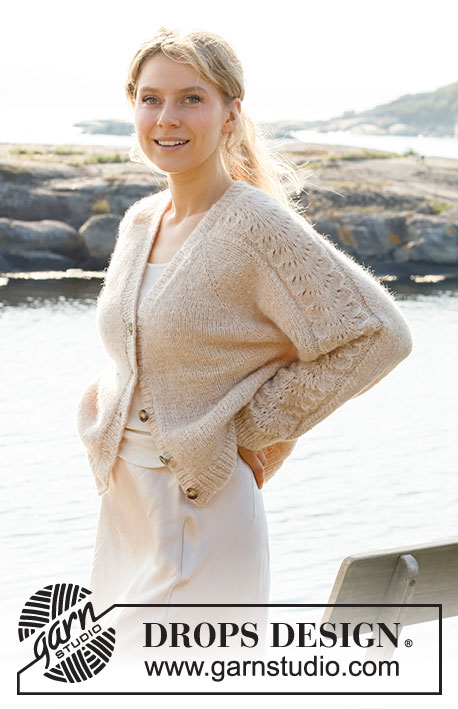
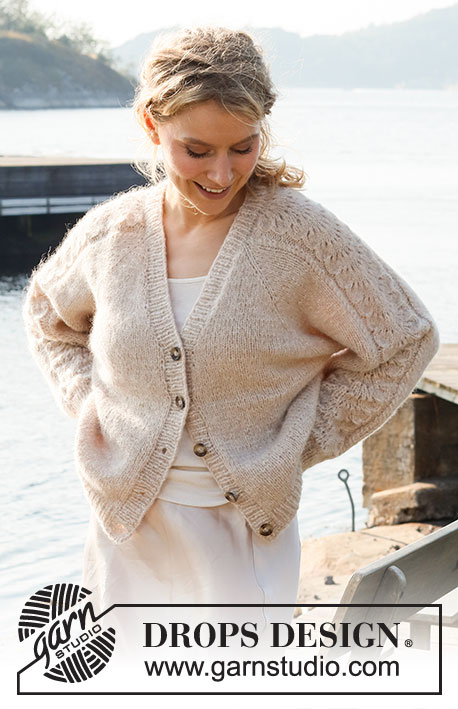




















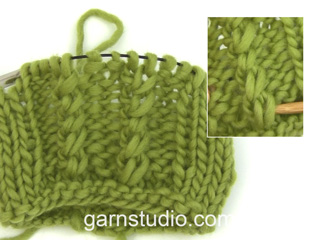

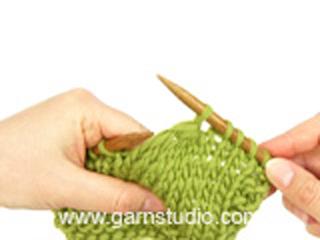
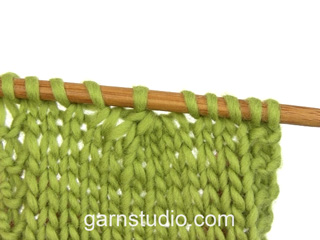








































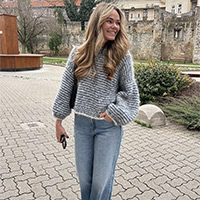

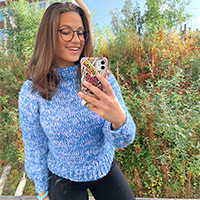
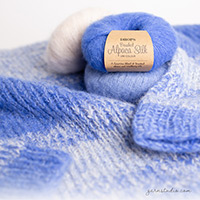


Comments / Questions (90)
Im making size L and ut's written that we should increase 27 times in total.. in total means including the increases we nade in chart A1? thanks
05.08.2022 - 16:39DROPS Design answered:
Yes, that's right. We have to work 2 things at the same time: pattern (A1, A2) and increasing for raglan (AT THE SAME TIME on first row from right side increase for RAGLAN in every transition between body and sleeves – read explanation above). Increasing for raglan have to be done 27 times in total, including the incr. in the first row.
05.08.2022 - 17:25When we finish chart A2 we start with A1then A2 again? and so on
05.08.2022 - 15:34DROPS Design answered:
Dear Mrs Albazzaz, after you have finished A.2 in height, repeat A.2 all the way (A.1 is worked only one time) to the end. Happy knitting!
05.08.2022 - 16:30When we finish chart A2 we A1again ?
05.08.2022 - 15:32But when we increase for the sleeves the stitch count won't be the same as the pattern in A1
04.08.2022 - 16:46DROPS Design answered:
Dear Mrs Albazzaz, A.1 is worked on the middle on top of sleeve one time in height, you then repeat A.2 in height to the end of sleeve. And raglan increases are worked on each side of the stitch with marker, maybe the 5th picture with focus on shoulder can help you vizualizing how it should look, you can see the stitch with marker = raglan stitch and increases on each side of this stitch, and also the wave pattern on mid on top of sleeve. Happy knitting!
05.08.2022 - 08:21I don't understand when we increase for the sleeves and when we don't .. i have just finshed the first time of chart A1.. could you please clarify?
04.08.2022 - 16:19DROPS Design answered:
Dear Mrs Albazzaz, increase for the raglan on either side of each of the 8 stitches with a marker at the transition of body and sleeves a total of 24-27-29-31-35-38 times on every other row (= every row from RS) - this means you will increase when working row 1, 3 and 5 in A.1 then increase in A.2 when working row 1, 3 and 5. Don't forget to increase for neck, starting on the 3rd row from RS. Happy knitting!
04.08.2022 - 16:24Hi.. i have just started with the bronze summer jacket .. i knitted the first three rows.. the first i purled all the stitches.. the second i knitted the front and back stitches , A1 diagram for sleeves and increasing at the same time.. the third i purled all the stitches and ptbl for the increases.. now for the next rows we work A1 diagram for sleeves and knit the rest of the stitches but Should i make the increases or no? thanks in advance
03.08.2022 - 14:35DROPS Design answered:
Dear Mrs Albazzaz, after you have worked the first 2 rows in A.1 continue working the remaining 3 rows (A.1 is 6 rows in total), and when A.1 is done in height, work now and repeat A.2 over A.1. At the same time, continue increasing for raglan as explained for your size. Happy knitting!
03.08.2022 - 15:19Hej, Är det någon som har stickat kofta nr 221-4? Jag förstår inte mönstret. Det gäller stycket, Översikt över nästa avsnitt, på sidan 3. Ska ökningarna ske både före och efter markeringarna eller bara på fram- och bakstycke? Varför jag frågar att för mig är det inte helt klart och tydligt.
09.07.2022 - 07:19DROPS Design answered:
Hej Astrid. Du ökar både före och efter markeringarna till raglan till det har ökats totalt 22-25-27-29-33-36 gånger på varje sida av de 4 maskorna med markör (dvs både på bakstycke, framstycken och ärmar). Efter det så ökar du bara på bakstycket och på framstyckena 2 gånger till. Mvh DROPS Design
12.07.2022 - 09:17Buenas tardes, cómo están? Dónde podría encontrar el vídeo que explica la ejecución del diagrama calado del modelo Bronze Summer? Muchas gracias por su respuesta. Saludos desde Argentina!!!
06.06.2022 - 02:00DROPS Design answered:
Hola Mirta, no tenemos vídeos que expliquen cómo trabajar todo el diagrama; puedes comprobar los vídeos relevantes para realizar esta labor aquí: https://www.garnstudio.com/video.php?patternid=10072&lang=es. También puedes leer la siguiente lección para entender mejor el diagrama: https://www.garnstudio.com/lesson.php?id=68&cid=23
06.06.2022 - 13:36What is meant to be done with the stitches with the marker thread in them? How do you know which section they belong to? For example, is the fourth stitch with the marker in it meant to be worked in stockinette or is it part of the sleeve pattern?
16.04.2022 - 18:48DROPS Design answered:
Dear Cora, the stitches with the marker thread are worked in stocking stitch, as indicated under RAGLAN. Happy knitting!
18.04.2022 - 20:29Hi. I understand we do raglan increases on Row 2 (the first RS row). Do we continue increases on Row 4? The pattern suggests we do not continue raglan increases until we have completed 1 vertical repeat of A.1 on the sleeves (which would be Row 8) but I think this is incorrect.
12.04.2022 - 05:24DROPS Design answered:
Hi Anna, You are right, you increase to raglan every second row (each row from the right side) at the same time as you work the pattern. Happy knitting!
12.04.2022 - 06:52